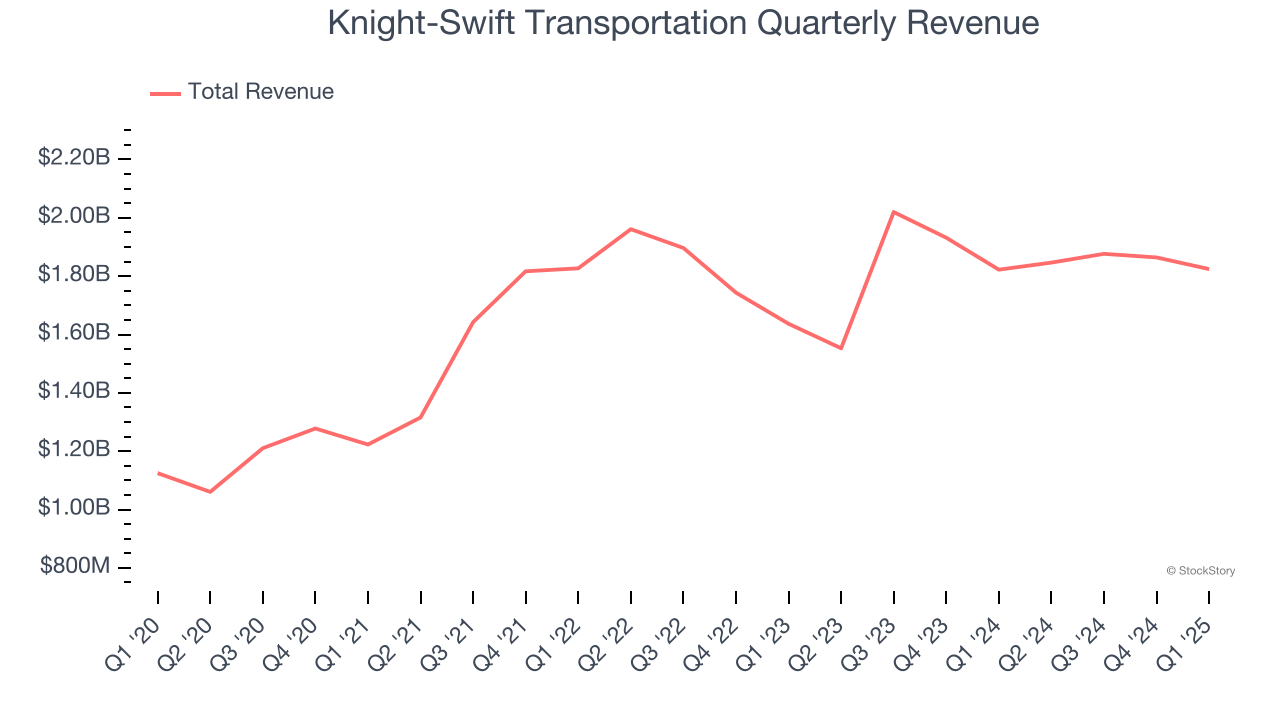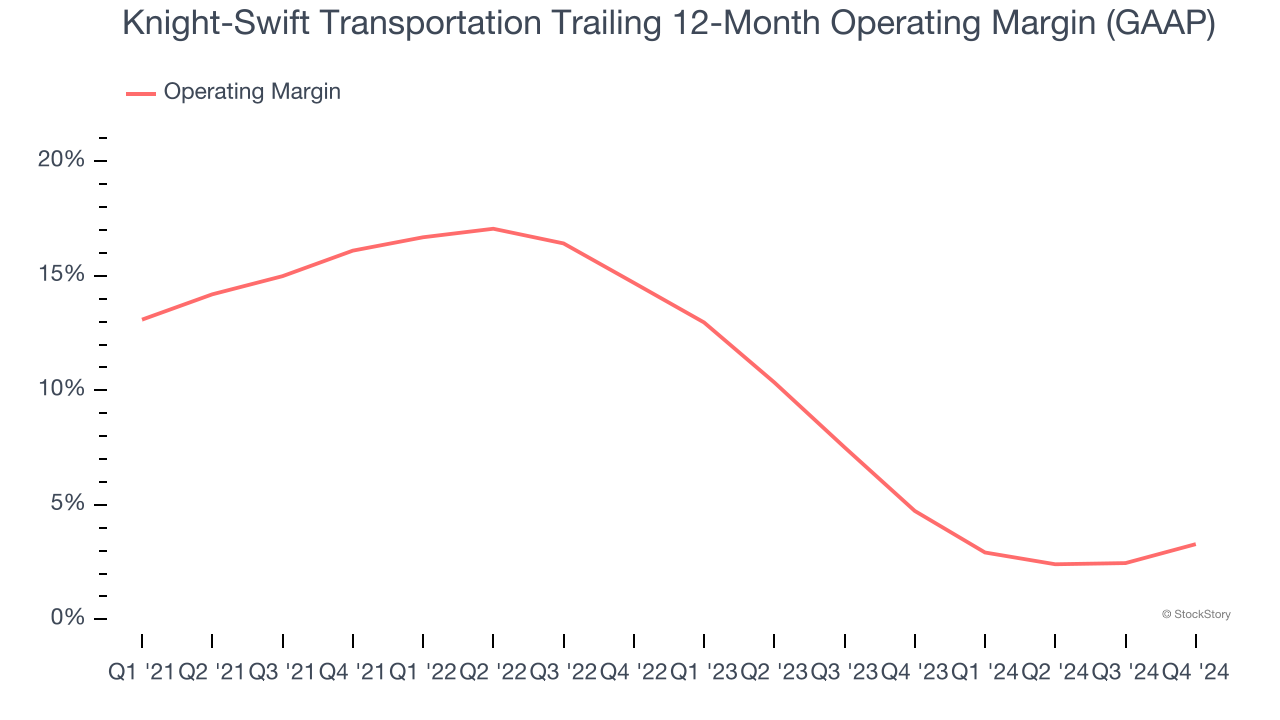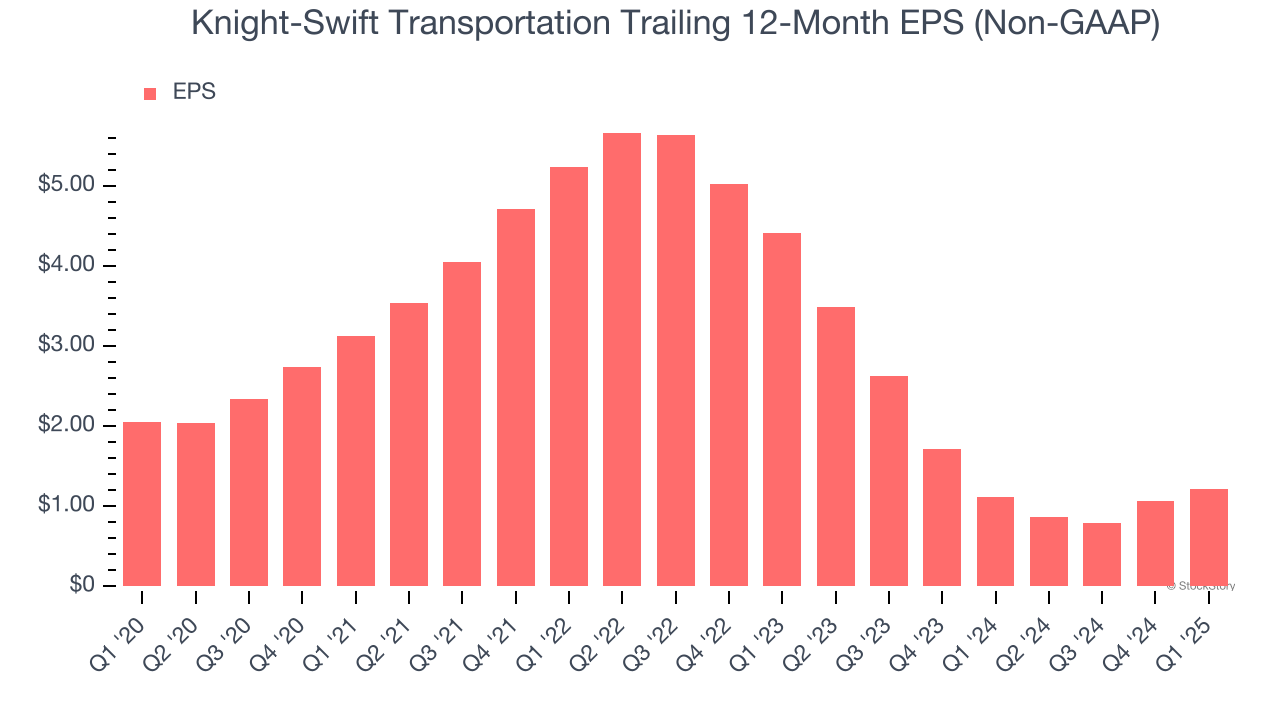
Freight delivery company Knight-Swift Transportation (NYSE: KNX) beat Wall Street’s revenue expectations in Q1 CY2025, but sales were flat year on year at $1.82 billion. Its non-GAAP profit of $0.28 per share was 18.7% above analysts’ consensus estimates.
Is now the time to buy Knight-Swift Transportation? Find out by accessing our full research report, it’s free.
Knight-Swift Transportation (KNX) Q1 CY2025 Highlights:
- Revenue: $1.82 billion vs analyst estimates of $1.80 billion (flat year on year, 1.6% beat)
- Adjusted EPS: $0.28 vs analyst estimates of $0.24 (18.7% beat)
- Adjusted EPS guidance for Q2 CY2025 is $0.34 at the midpoint, below analyst estimates of $0.40
- Free Cash Flow was -$12.62 million compared to -$104 million in the same quarter last year
- Market Capitalization: $6.32 billion
Company Overview
Covering 1.6 billion loaded miles in 2023 alone, Knight-Swift Transportation (NYSE: KNX) offers less-than-truckload and full truckload delivery services.
Ground Transportation
The growth of e-commerce and global trade continues to drive demand for shipping services, especially last-mile delivery, presenting opportunities for ground transportation companies. The industry continues to invest in data, analytics, and autonomous fleets to optimize efficiency and find the most cost-effective routes. Despite the essential services this industry provides, ground transportation companies are still at the whim of economic cycles. Consumer spending, for example, can greatly impact the demand for these companies’ offerings while fuel costs can influence profit margins.
Sales Growth
Reviewing a company’s long-term sales performance reveals insights into its quality. Any business can put up a good quarter or two, but the best consistently grow over the long haul. Over the last five years, Knight-Swift Transportation grew its sales at a solid 9.2% compounded annual growth rate. Its growth beat the average industrials company and shows its offerings resonate with customers.

We at StockStory place the most emphasis on long-term growth, but within industrials, a half-decade historical view may miss cycles, industry trends, or a company capitalizing on catalysts such as a new contract win or a successful product line. Knight-Swift Transportation’s recent performance shows its demand has slowed as its annualized revenue growth of 1.2% over the last two years was below its five-year trend. We also note many other Ground Transportation businesses have faced declining sales because of cyclical headwinds. While Knight-Swift Transportation grew slower than we’d like, it did do better than its peers. 
This quarter, Knight-Swift Transportation’s $1.82 billion of revenue was flat year on year but beat Wall Street’s estimates by 1.6%.
Looking ahead, sell-side analysts expect revenue to grow 4.3% over the next 12 months. Although this projection implies its newer products and services will fuel better top-line performance, it is still below the sector average.
Software is eating the world and there is virtually no industry left that has been untouched by it. That drives increasing demand for tools helping software developers do their jobs, whether it be monitoring critical cloud infrastructure, integrating audio and video functionality, or ensuring smooth content streaming. Click here to access a free report on our 3 favorite stocks to play this generational megatrend.
Operating Margin
Operating margin is an important measure of profitability as it shows the portion of revenue left after accounting for all core expenses – everything from the cost of goods sold to advertising and wages. It’s also useful for comparing profitability across companies with different levels of debt and tax rates because it excludes interest and taxes.
Knight-Swift Transportation has done a decent job managing its cost base over the last five years. The company has produced an average operating margin of 9.8%, higher than the broader industrials sector.
Looking at the trend in its profitability, Knight-Swift Transportation’s operating margin decreased by 9 percentage points over the last five years. This raises questions about the company’s expense base because its revenue growth should have given it leverage on its fixed costs, resulting in better economies of scale and profitability.

Earnings Per Share
We track the long-term change in earnings per share (EPS) for the same reason as long-term revenue growth. Compared to revenue, however, EPS highlights whether a company’s growth is profitable.
Sadly for Knight-Swift Transportation, its EPS declined by 9.9% annually over the last five years while its revenue grew by 9.2%. This tells us the company became less profitable on a per-share basis as it expanded due to non-fundamental factors such as interest expenses and taxes.

Diving into the nuances of Knight-Swift Transportation’s earnings can give us a better understanding of its performance. As we mentioned earlier, Knight-Swift Transportation’s operating margin declined by 9 percentage points over the last five years. This was the most relevant factor (aside from the revenue impact) behind its lower earnings; taxes and interest expenses can also affect EPS but don’t tell us as much about a company’s fundamentals.
Like with revenue, we analyze EPS over a shorter period to see if we are missing a change in the business.
For Knight-Swift Transportation, its two-year annual EPS declines of 47.4% show it’s continued to underperform. These results were bad no matter how you slice the data.
In Q1, Knight-Swift Transportation reported EPS at $0.28, up from $0.12 in the same quarter last year. This print easily cleared analysts’ estimates, and shareholders should be content with the results. Over the next 12 months, Wall Street expects Knight-Swift Transportation’s full-year EPS of $1.22 to grow 60.8%.
Key Takeaways from Knight-Swift Transportation’s Q1 Results
We enjoyed seeing Knight-Swift Transportation beat analysts’ revenue and EPS expectations this quarter. On the other hand, its EPS guidance for next quarter missed significantly. Overall, we think this was a mixed quarter. The market seemed to focus on the negatives, and the stock traded down 3.4% to $38.25 immediately following the results.
So should you invest in Knight-Swift Transportation right now? What happened in the latest quarter matters, but not as much as longer-term business quality and valuation, when deciding whether to invest in this stock. We cover that in our actionable full research report which you can read here, it’s free.





